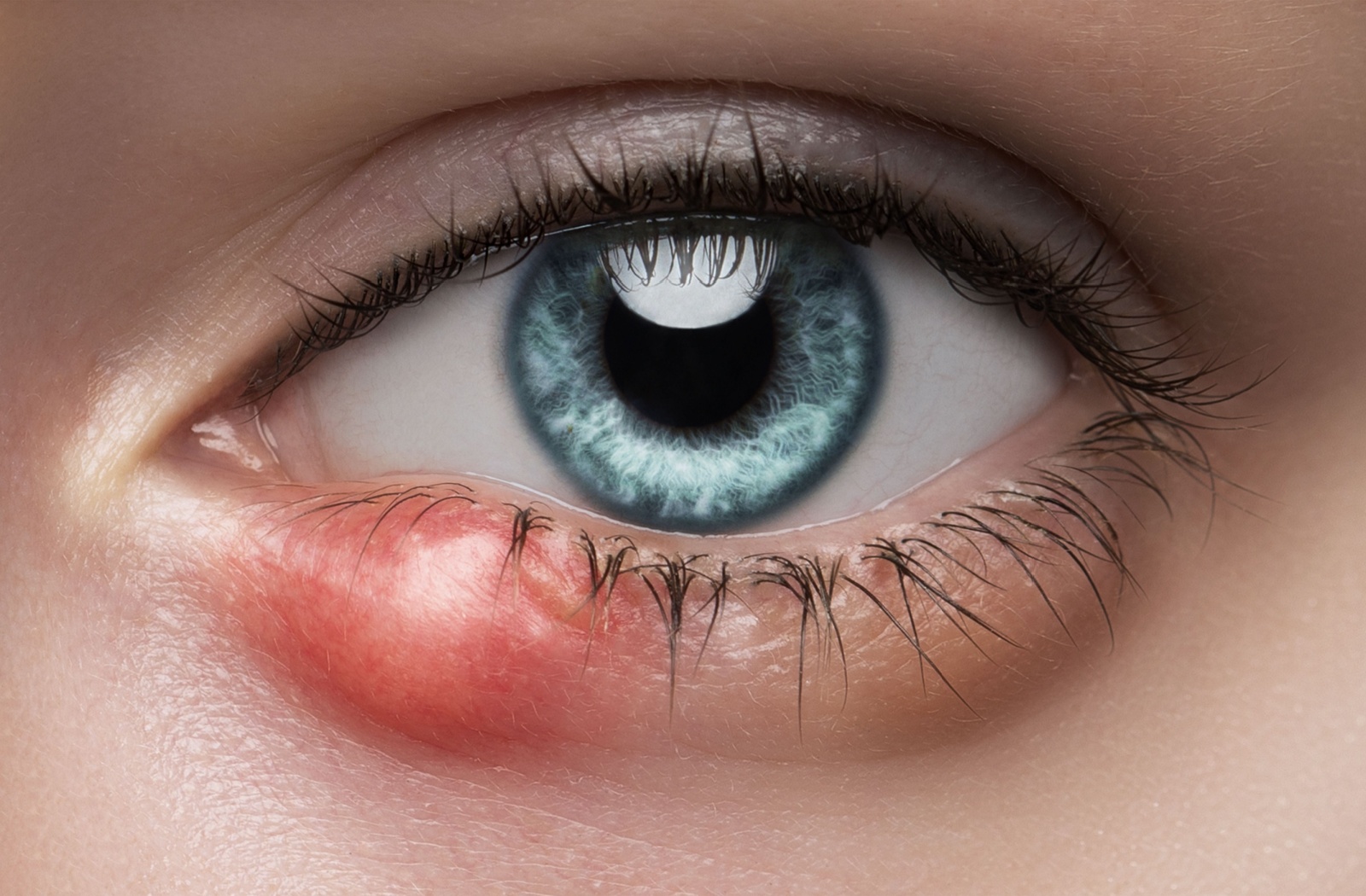Eye infections can be worrisome, especially when you’re unsure if you’re dealing with pink eye (conjunctivitis) or a stye (hordeolum). Both conditions are common and can cause discomfort around the eyes, and can impact eye health, but they have distinct symptoms and treatments. This guide will help you understand the differences and seek appropriate care at your next eye exam.
Understanding Pink Eye
Pink eye, or conjunctivitis, is an inflammation of the conjunctiva, which is the thin, transparent tissue covering both the white part of the eye and the inside of the eyelids. This common eye condition can lead to redness, itching, and sometimes a discharge that can crust over during sleep.
It can be caused by various factors, including viruses such as adenovirus, bacteria like Streptococcus or Staphylococcus, allergens such as pollen or dust, or irritants like smoke or chlorine from swimming pools. While usually mild, it can be contagious and sometimes requires medical attention to prevent complications or ease symptoms.
Symptoms of Pink Eye
- Redness in the white of the eye and the inner eyelid.
- Watery discharge is typically clear in viral cases.
- Thick, yellow-green discharge in bacterial conjunctivitis, which may cause the eyelids to stick together.
- Itchiness and irritation, often associated with allergic conjunctivitis.
- Swelling of the conjunctiva.
- Sensitivity to light.
Types of Pink Eye
- Viral conjunctivitis: Often associated with colds, it is the most contagious form.
- Bacterial conjunctivitis: Caused by bacteria, such as Staphylococcus or Streptococcus, and also highly contagious.
- Allergic conjunctivitis: Triggered by allergens like pollen or pet dander. Not contagious.
- Irritant conjunctivitis: Resulting from chemical exposure, smoke, or dust.

Understanding a Stye
A stye is an inflamed oil gland that appears on the edge of the eyelid, much like a small pimple. A bacterial infection typically causes this condition, often involving the bacteria Staphylococcus.
Styes can cause discomfort, redness, and swelling in the affected area. They are usually harmless and tend to resolve on their own within a week, but warm compresses can help speed up the healing process. Maintaining good eyelid hygiene can also prevent their occurrence.
Symptoms of a Stye
- A red, painful lump near the edge of the eyelid, resembling a pimple.
- Swelling around the eyelid.
- Tenderness in the area.
- Tearing or watery eyes.
- Crusting along the eyelid margin.
Causes of a Stye
Styes are typically caused by a bacterial infection, most often Staphylococcus, which infects the oil glands in the eyelid.
Key Differences Between Pink Eye and a Stye
- Location:
- Pink Eye: Affects the conjunctiva.
- Stye: Occurs on the eyelid margin or inside the eyelid.
- Appearance:
- Pink Eye: Uniform redness in the white of the eye.
- Stye: Localized red bump on the eyelid.
- Discharge:
- Pink Eye: Watery or thick discharge.
- Stye: Minimal discharge, more crusting.
- Contagion:
- Pink Eye: Viral and bacterial forms are highly contagious.
- Stye: Generally not contagious.
Diagnosis and Treatment
Diagnosing Pink Eye
For an accurate diagnosis, consult an eye care professional. They will examine your symptoms, ask about recent illnesses, and may take a sample of eye discharge to identify the cause.
Treating Pink Eye
- Viral Conjunctivitis:
- Usually resolves on its own within 1-2 weeks.
- Apply cool compresses to soothe irritation.
- Maintain good hygiene to prevent spreading.
- Bacterial Conjunctivitis:
- Antibiotic eye drops or ointments may be prescribed.
- Practice good hand hygiene to avoid spreading.
- Allergic Conjunctivitis:
- Use antihistamine or anti-inflammatory eye drops.
- Avoid known allergens and keep windows closed during high pollen seasons.
- Irritant Conjunctivitis:
- Rinse the eyes with cool water.
- Avoid further exposure to irritants.
Diagnosing a Stye
Styes are usually diagnosed through a simple examination by an eye care professional. They will inspect the eyelid and may ask about your symptoms.
Treating a Stye
- Warm Compresses and Lid Wipes:
- Apply a warm, damp cloth to the affected eye for 10-15 minutes, 3-4 times a day.
- This helps the stye drain naturally.
- After using a warm compress, use medicated eyelid wipes to remove any remaining crust/debris, reducing the risk of bacterial infections. Lid wipes are specially formulated for your eyes, and are much more effective than simply rinsing with water.
- Avoid Squeezing:
- Do not attempt to pop or squeeze the stye, as this can spread the infection.
- Antibiotics:
- If the stye does not improve, an antibiotic ointment may be prescribed.
- Good Eyelid Hygiene:
- Keep your eyelids clean and free from makeup until the stye heals.
- We also recommend using hypochlorous acid (HOCL) sprays to practice proper eyelid hygiene.
- Hypochlorous acid is a natural antimicrobial agent and is used as an effective disinfectant in a variety of medical applications.
- When applied to the area around the eye, HOCL sprays have been shown to be an effective treatment for killing bacteria and treating blepharitis.
- Your optometrist will help develop a personalized treatment plan for you.
Prevention Tips
- Wash Your Hands:
- Regularly wash your hands with soap and water to avoid transferring infections.
- Avoid Touching Your Eyes:
- Refrain from rubbing or touching your eyes to prevent irritation and infection.
- Don’t Share Personal Items:
- Do not share towels, pillowcases, or eye makeup.
- Maintain Cleanliness:
- Keep contact lenses, eyeglasses, and makeup brushes clean.
Thinking About Booking Your Next Eye Appointment
Knowing the differences between pink eye and a stye can help you seek the right treatment and prevent complications. If you’re unsure about your symptoms or worsen, consulting an eye care professional is always the best course of action. For more information and treatment, please contact Mint Eyecare in Brampton, ON. Don’t live with discomfort, our team of professionals can help make sure you get the right relief.




